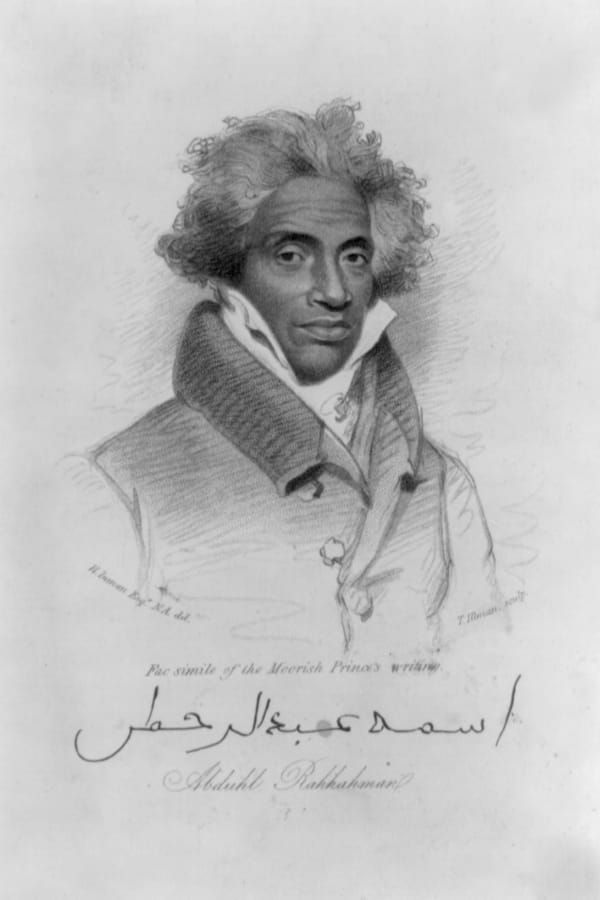Recovered Roots
A Moroccan Exploring Florida & The Southwest
Mustafa Azemmouri (sometimes referred to as Estevancio) was captured into slavery in Morocco and taken on an expedition by Spanish explorer to establish a colony in Florida and the unexplored lands to the West. In the year 1528, the expedition landed in what is today western Florida. Several years later, Azemmouri continued on to explore what is today Arizona and New Mexico. In 1539, he was chosen by the Viceroy of New Spain (Mexico) to guide another expedition to the Southwest, becoming perhaps the first non-Native American to visit Pueblo lands.

An Early Narrative Of Slavery From Maryland
Ayuba Suleiman Diallo (also known as Job Ben Solomon), who came from a family of prominent religious scholars in Senegal, was abducted and transported to Maryland on a slave ship in 1730. While held in bondage, Diallo met a Maryland judge named Thomas Bluett, who was so impressed with the young man that he wrote Diallo’s biography, published under the title “Some Memoirs of the Life of Job.” With Bluett’s assistance, Diallo has his freedom purchased by the director of the Royal African Company and was sent to England, before returning home to West Africa.

Prince In Bondage Meets The President
Abdul-Rahman Ibn Ibrahima Sori, the prince of tribe in what is today Guinea, was captured in battle in 1788, sold into slavery, and eventually purchased by a slave-owner in Natchez, Mississippi. After more than two decades in bondage, a campaign to secure his freedom was led by Andrew Marschalk, editor of the Mississippi State Gazette, with the aid of Senator Thomas Reed and Secretary of State Henry Clay. Before returning to Africa, Abdul-Rahman tried to raise funds to free his children from slavery as well. He went to Washington and met with President John Quincy Adams, but he had to return to Africa without his children. He wrote two autobiographies and his portrait is displayed in the Library of Congress. Today some of his descendants still like in Natchez, Mississippi. “Prince Among Slaves,” a 2006 PBS documentary about Abdul-Rahman, was narrated by Mos Def.

Self-liberated Financier In Georgetown
Captured in a West African slave raid as a teenager, Yarrow Mamout came to America on a slave ship. Ye the ultimately purchased his own freedom after over forty years in bondage and became a famous financier in Washington, D.C.–a testament to the American spirit of overcoming adversity to build a better future. From the garden of his home in Georgetown, he prayed toward Mecca. His descendant Robert Turner Ford graduated from Harvard in 1927. His portrait hangs in the “American Origins” section of the Smithsonian National Portrait Gallery. The Philadelphia Museum of Art also includes a portrait of Mamout by Charles Willson Peale, who also painted George Washington, Benjamin Franklin and Thomas Jefferson.

A Mosque In Georgia
Bilali Muhammad, a native of Guinea, was abducted into slavery and shipped to a plantation on Sapelo Island off the coast of Georgia. The man who owned him, Thomas Spalding, allowed Bilalia to practice his religion openly and even construct a small mosque on the plantation. During the War of 1812, Spalding fled his plantation fearing a British attack–and left Bilali with 80 muskets to help organize the plantation’s defense. He also saved many lives during a hurricane in 1824. Bilalia gave his children Muslim names, performed daily prayers, and was buried with his prayer rug and Qur’an. He left behind a 13-page Arabic manuscript with passages from a 10th Century treatise on Islamic law, written down entirely from memory. The Bilali document, likely the first work of Islamic jurisprudence written in the U.S., sits in the archives of the Hargrett Rare Book & Manuscript Library at the University of Georgia.

A North Carolina Narrative Of Slavery… In Arabic
Al Haj Umar ibn Said, enslaved in Senegal at age 37, was transported to Charleston, South Carolina but soon fled his cruel slave-owner to Fayetteville, North Carolina. In 1831, he wrote a 16-page autobiography in Arabic, now archived in the Library of Congress. It is the only known existing American slave narrative written in Arabic–and unlike many English slave narratives was not edited by white slave masters. The Masjid Omar Ibn Sayyid on Southern Avenue in Fayetteville is named in his honor.
